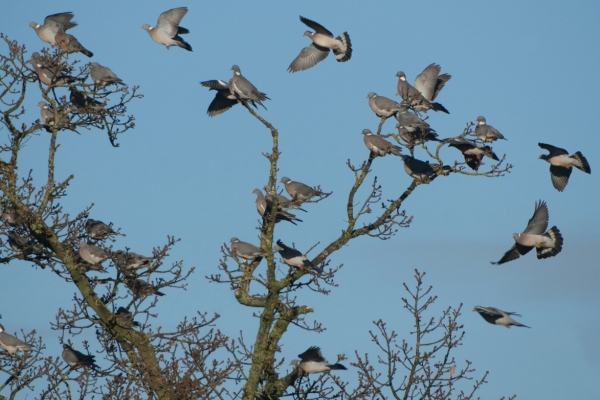
Flying the roost
BASC member Richard Hall shares his journey from clay shooting to the rewarding experience of roost shooting.
Get information on the legal shooting season for mammals and birds in the UK.
Apply for funding for your project or make a donation today
Comprehensive information and advice from our specialist firearms team.
Everything you need to know about shotgun, rifle and airgun ammunition.
Find our up-to-date information, advice and links to government resources.
Everything you need to know on firearms law and licensing.
All the latest news and advice on general licences and how they affect you.
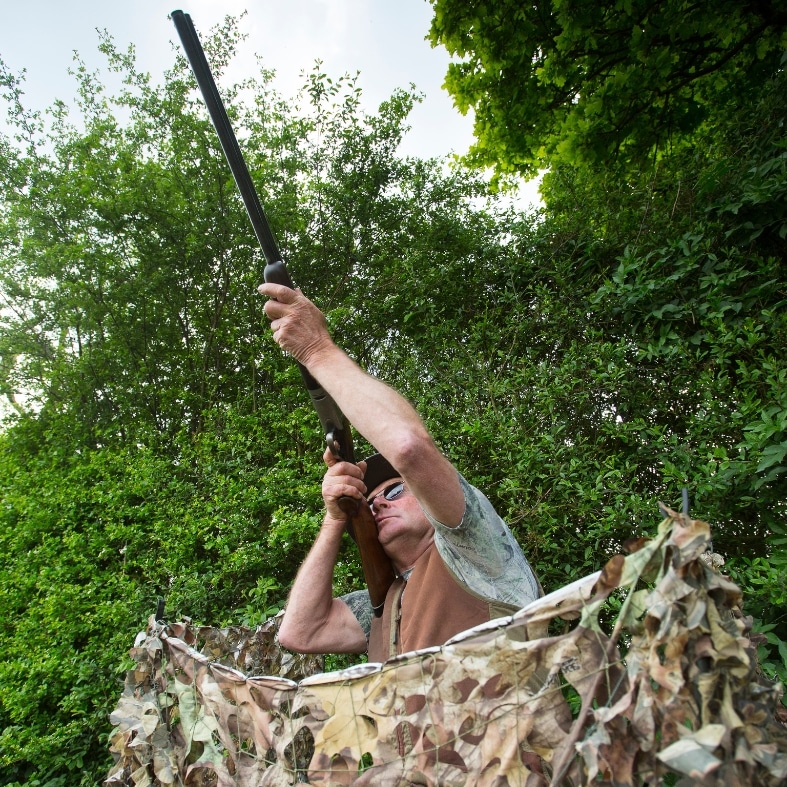

Successful pigeon control is an endless learning curve, as BASC East director Terry Behan knows from 40 years of hard-earned experience.
As the weather warms up and the days get longer, my focus turns to crop protection. That’s not to say I am not always looking out for pigeons, but with the game and wildfowling season over, pigeons are now at the very forefront for me.
I never tire of the challenge of trying to understand which field is best to shoot at what time of year, or what decoy pattern to consider. Should I use a magnet or a flapper, or maybe both? The one common denominator I have learnt, though, is that if you do not put in the time beforehand, then you will be extremely lucky to have a productive day.
Of course, there is nothing wrong with going decoying for the day and shooting a modest bag. We all know how good it is for you to be in the countryside harvesting wild food, and I am sure the farmer will appreciate you spending your time protecting his crops.
Also, let’s not forget how much our dogs love being in the field. For instance, my spaniel will stare through a decoy net for hours in pure happiness waiting for the opportunity of a retrieve.
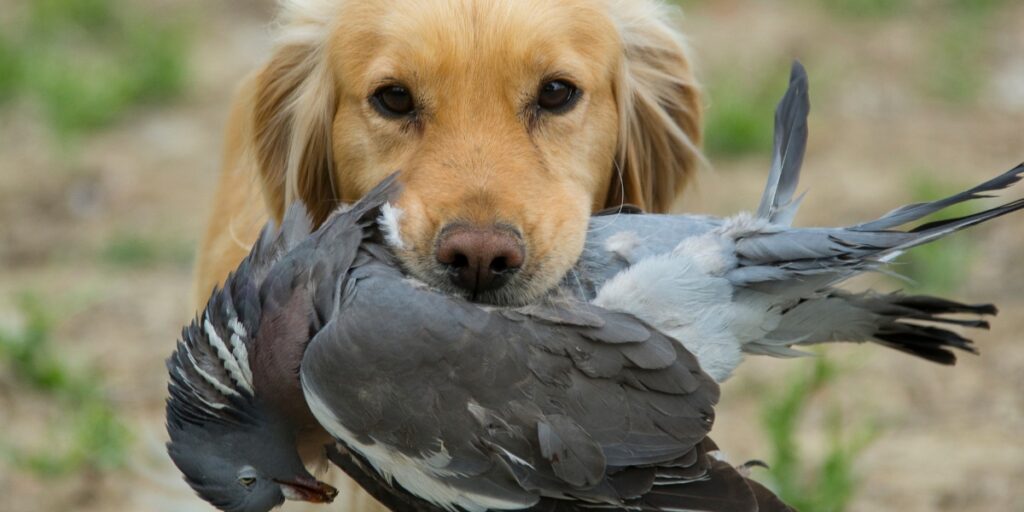
But when I refer to the challenge, I mean shooting enough pigeons to have an impact, to either move them on or to reduce the number on that crop. That outcome will always be subject to the number of pigeons in the field, but for many the golden number for a day’s pigeon shooting is 100. To this day I still do not know why this is but, like every pigeon shooter I know, I am always extremely happy when the clicker reaches that significant milestone.
Maybe it’s because it’s a landmark which demonstrates we have achieved the essential task of a pigeon shooter, which is to undertake crop protection effectively.
Maybe it’s because we have harvested some delicious sustainable food, or it might be that with two shots to one bird ratio (or better) we have had a fantastic day’s sport and have acquitted ourselves effectively. In truth, you cannot do one of these without the other when it comes to pigeon shooting.
The topic of shot-to-kill ratio leads me to think of the cartridges I might use this year. It will be no surprise that I shoot sustainable ammunition, and in the past I have used many types. However, most were aimed at game shooting, loaded with 32g of 3 or 4s. Now there is more choice for the pigeon shooter, with loads such as the Jocker 27g 4s with paper wads, and Eley traditional steel 30g 4s.
I have used both on pigeons and they work extremely well. They are both 2.5″ standard performance steel, so suitable for most guns if they are choked correctly.
The cost of these cartridges was also very reasonable, considering the new technology used. The Jockers were around £350 per thousand and the Eley were £500 per thousand.
There are also suitable pigeon cartridges from Gamebore, Bioammo, Hull, B&P and Lyalvale worth considering. And for those of you who favour a 16 bore, Hull also has a 28g 5 shot which will be a fantastic pigeon cartridge and worth considering.
Obviously before you head out for a day’s crop protection, you need to be aware of the general licences and the guidance within them. For instance, do you have to undertake measures before you can shoot? Do you have to record the times you have tried alternative non-lethal methods?
Of course, you would consider non-lethal methods; however, lived experience demonstrates they do not work. Bangers, flags and scarers will only work for a very short period, if at all.
I have witnessed flags put out in the morning and pigeons landing closer than one metre to them by the end of a day. And let’s be honest, if bangers were effective, we would not be able to decoy woodpigeons at all, given that on a 100-bird day at 2-1 ratio that’s 200 bangs, and they just keep coming. The general licence is clear and states that:
“You do not need to use non-lethal methods of control or to continue to use them if you have tried them or if you consider them to be:
• not practical
• not effective
• disproportionate”
So, it is up to the user to decide what needs to be done and to decide what is proportionate and reasonable. My advice would be to consider it, but do not labour it and have your reasons prepared as to why you are undertaking lethal control.
Also, make sure you read our Woodpigeon Code of Practice and always use it as a handy guide.
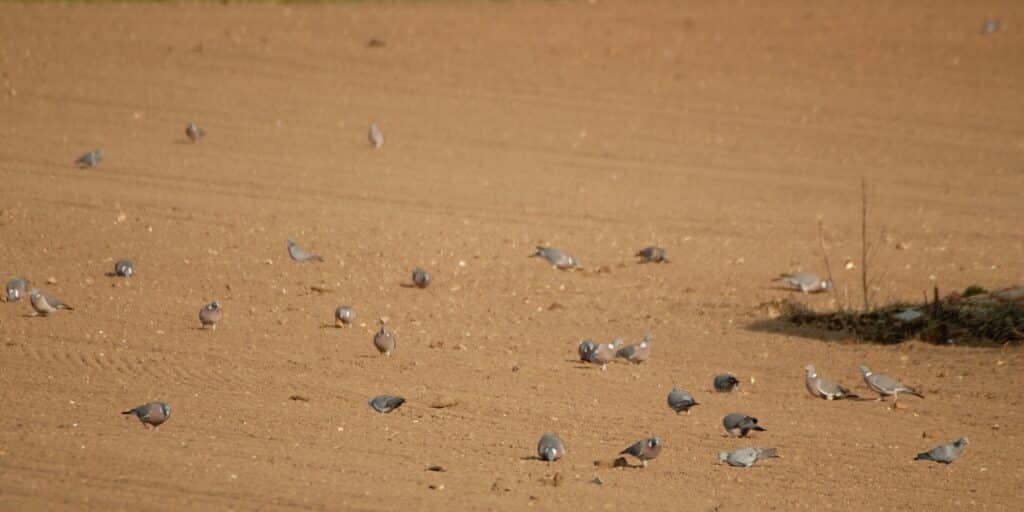
Now that the serious stuff is out the way, what will the pigeons most likely be feeding on at this time of year? Well, food starts to become plentiful, subject to the winter we have had and the times crops have been drilled.
Oilseed rape will be a good bet. It’s a sustainable food source for pigeons in the cold months. You will also find them on oilseed rape through summer in low spots, so be sure to have a good look on fields. It’s a good idea to walk the boundary, because you could find one of your best days on the far corner of that very large field that you’ve not tried before.
With farm machinery getting better and injecting seed directly into the ground, the days of grain laying on the surface after spring drillings are few and far between; however, they do still come up, so keep a lookout.
After the field has been drilled, keep a watching eye as you pass. When the crops start to grow, the pigeons will find it and if you watch, the numbers will increase. This is the time you will have to make a call. You could go too early and shoot a few where waiting a day could lead to double the numbers. But the risk is they could then move on and you shoot less, or someone else may arrive and shoot it the day before you. So how do you make the right call? Sadly, I don’t have all the answers, but experience and gut feeling will tell you where and when to shoot.
The truth is the best way to learn is, to get it wrong, and quite possibly many times. But each time you get it wrong, you will learn something, and that’s the ‘challenge’ I referred to at the start. There is almost no substitute for experience when it comes to successful pigeon control. Yes, you can read the books and watch the videos and you may be lucky enough to have an experienced mentor, but the bottom line is that you need to put the hours in.
It is also worth considering volunteer crops when undertaking your reconnaissance. I have had many a good day on fields that have been left that year, shooting over self-sown rape, wheat, and clover. As mentioned above, the more you experience, the more you learn, but it can become a bit addictive and the phrase ‘just popping out for a recce’ may become quite familiar to you.
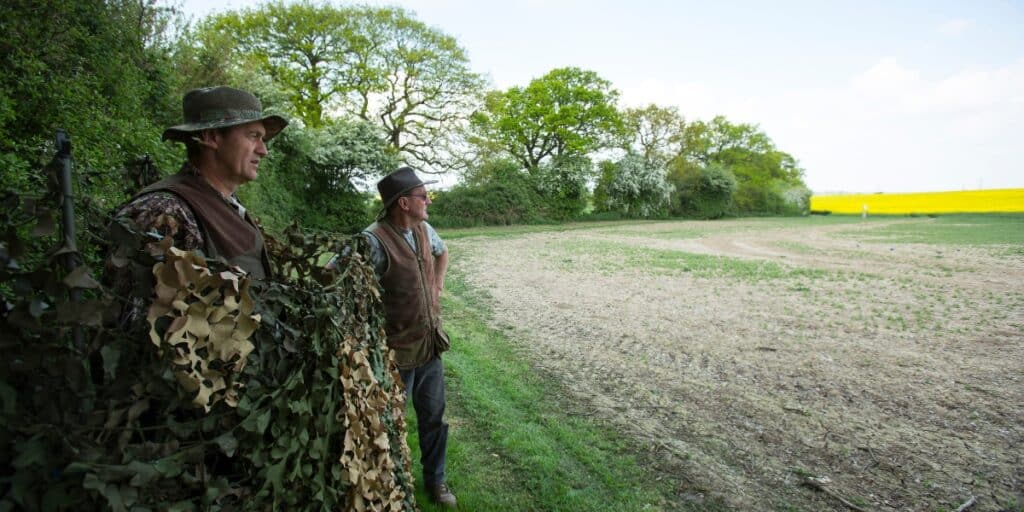
Where should it be, what size should it be and, more importantly, what type of camouflage should you use? Well, on a good day when the birds are pouring in it’s almost as if you can sit there without a hide, be still and the birds will come. But on a day when the birds are a little wiser and very twitchy, you only have to move slightly and they flare away.
My preference has always been lightweight and as small as possible, with poles and a net. Use a net that is layered mesh because this breaks up your silhouette as you sit and wait for the pigeons. Set it up in a way that you can see through it or through gaps in it, rather than keep lifting your head above the net like a moon rising over the horizon. This is often referred to as ‘the moon face’ and will induce a rapid about-turn for any incoming pigeon.
Try to use a net that is lighter in colour than the cover around you. If you only have one net, then use that and break up the colours by laying some cover on it that replicates your background.
Ensure the cover at the rear of your hide is thicker, either by doubling up the net or laying cover on it. This will prevent the front of your net from becoming transparent and thereby stop your silhouette or shadows being seen from far away.
Remember, it is the movement that scares pigeons, so move slowly as you take your shot, and if they flare then wait and take your shot when you see a true line on a bird.
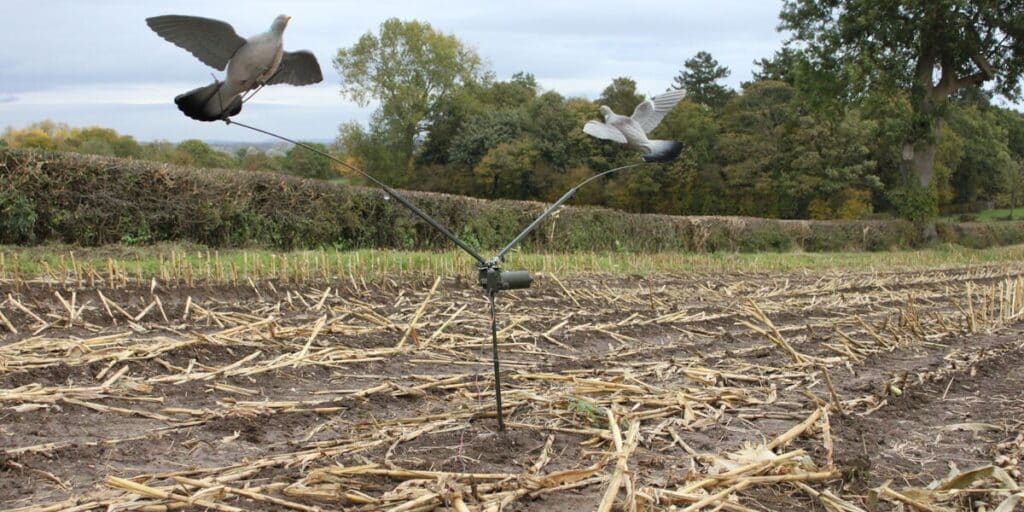
What pattern should you use with your decoys? This is simple; one that works. There is no right or wrong pattern. I have studied pigeons for nearly 40 years, and I have not seen them in the same formation once. Start with your decoys replicating what you saw the pigeons doing in the field when you did your recce. If you saw lots of birds, then use lots of decoys and conversely, if there was only a scattering, then copy that with your decoys.
Patterns are important to manoeuvre the birds to where you want to shoot them. Put your decoys out in front of you with a reasonable gap between you and the first one, and then adjust your pattern once you have studied the birds in flight on the day. I cannot recall a time I put out a decoy pattern and did not change it, and sometimes I will do that several times.
There is no complete art to pigeon shooting; it’s an endless learning curve. But one which delivers great service to the farmers and plenty of wild, sustainable and delicious food to the kitchen (you can find many recipes on the Eat Game website).
If you’re new to pigeon shooting, BASC holds Introduction to Woodpigeon courses which will help.


BASC member Richard Hall shares his journey from clay shooting to the rewarding experience of roost shooting.
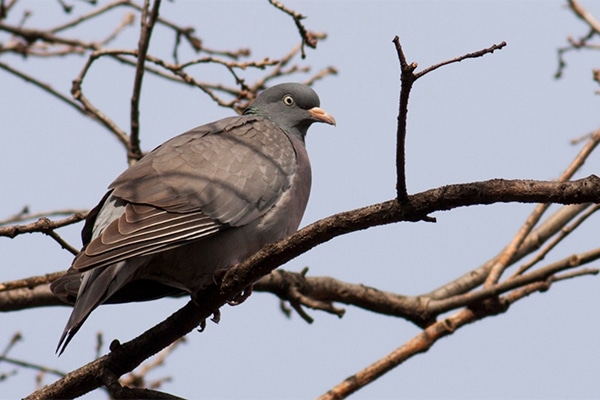
Tackling woodpigeons as they descend on their favoured roosting spots is one of the most exhilarating forms of shooting.
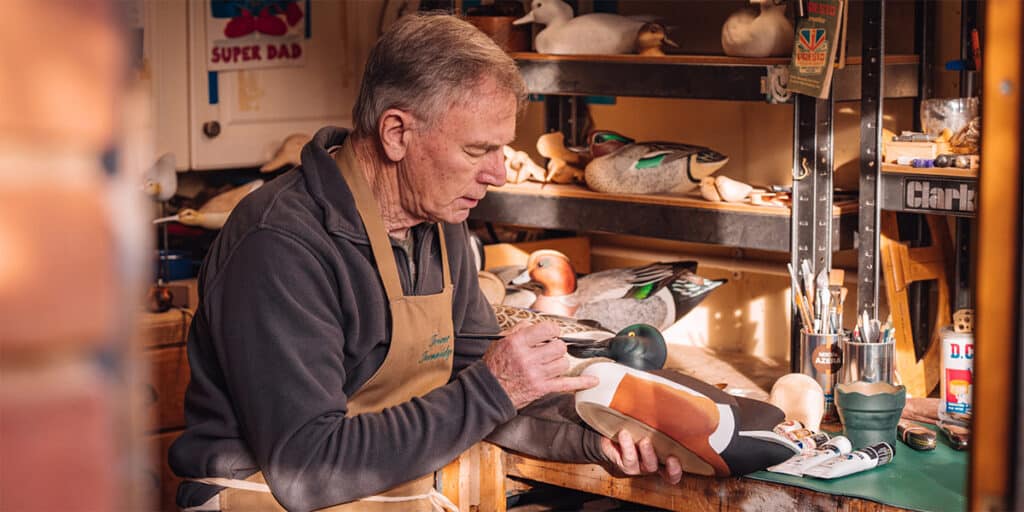
The quality of Trevor’s decoys speaks for itself and his work has been recognised in wood carving championships and a stream of commissions.